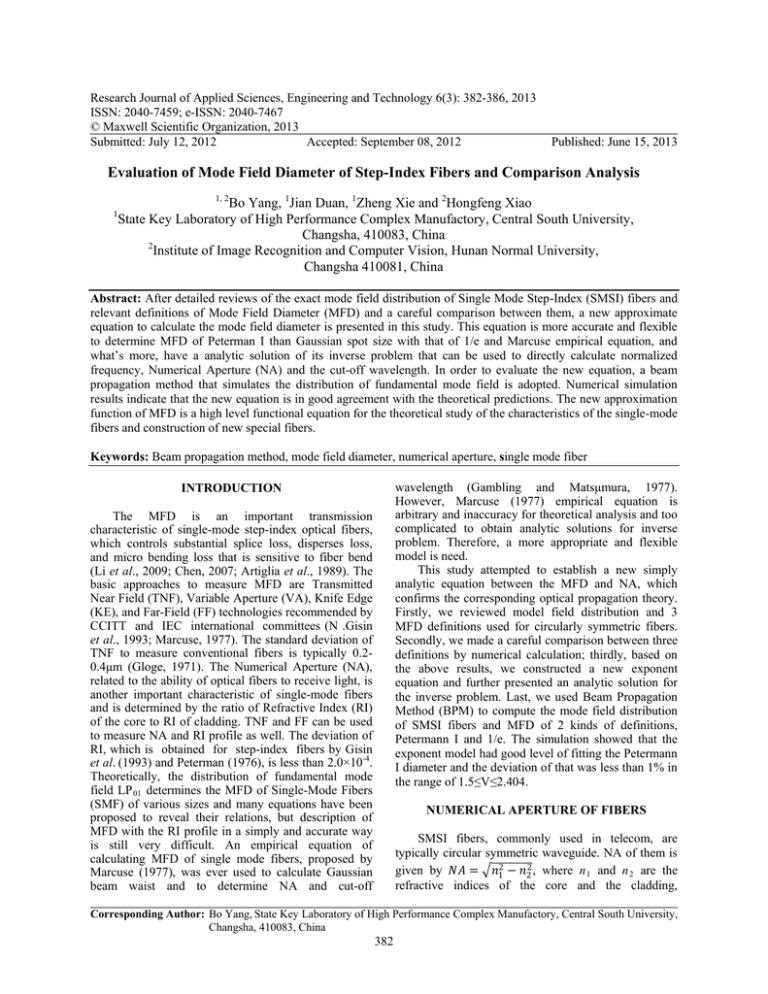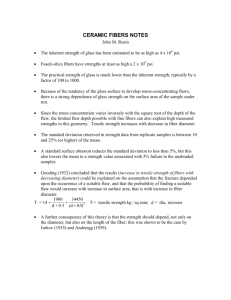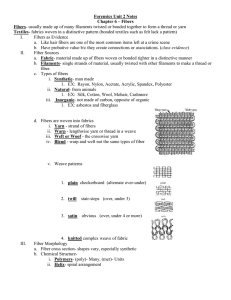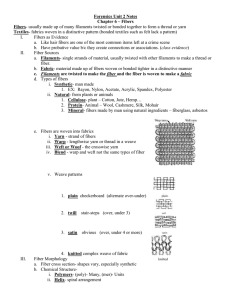Research Journal of Applied Sciences, Engineering and Technology 6(3): 382-386,... ISSN: 2040-7459; e-ISSN: 2040-7467
advertisement

Research Journal of Applied Sciences, Engineering and Technology 6(3): 382-386, 2013 ISSN: 2040-7459; e-ISSN: 2040-7467 © Maxwell Scientific Organization, 2013 Submitted: July 12, 2012 Accepted: September 08, 2012 Published: June 15, 2013 Evaluation of Mode Field Diameter of Step-Index Fibers and Comparison Analysis 1, 2 Bo Yang, 1Jian Duan, 1Zheng Xie and 2Hongfeng Xiao State Key Laboratory of High Performance Complex Manufactory, Central South University, Changsha, 410083, China 2 Institute of Image Recognition and Computer Vision, Hunan Normal University, Changsha 410081, China 1 Abstract: After detailed reviews of the exact mode field distribution of Single Mode Step-Index (SMSI) fibers and relevant definitions of Mode Field Diameter (MFD) and a careful comparison between them, a new approximate equation to calculate the mode field diameter is presented in this study. This equation is more accurate and flexible to determine MFD of Peterman I than Gaussian spot size with that of 1/e and Marcuse empirical equation, and what’s more, have a analytic solution of its inverse problem that can be used to directly calculate normalized frequency, Numerical Aperture (NA) and the cut-off wavelength. In order to evaluate the new equation, a beam propagation method that simulates the distribution of fundamental mode field is adopted. Numerical simulation results indicate that the new equation is in good agreement with the theoretical predictions. The new approximation function of MFD is a high level functional equation for the theoretical study of the characteristics of the single-mode fibers and construction of new special fibers. Keywords: Beam propagation method, mode field diameter, numerical aperture, single mode fiber wavelength (Gambling and Matsμmura, 1977). However, Marcuse (1977) empirical equation is arbitrary and inaccuracy for theoretical analysis and too complicated to obtain analytic solutions for inverse problem. Therefore, a more appropriate and flexible model is need. This study attempted to establish a new simply analytic equation between the MFD and NA, which confirms the corresponding optical propagation theory. Firstly, we reviewed model field distribution and 3 MFD definitions used for circularly symmetric fibers. Secondly, we made a careful comparison between three definitions by numerical calculation; thirdly, based on the above results, we constructed a new exponent equation and further presented an analytic solution for the inverse problem. Last, we used Beam Propagation Method (BPM) to compute the mode field distribution of SMSI fibers and MFD of 2 kinds of definitions, Petermann I and 1/e. The simulation showed that the exponent model had good level of fitting the Petermann I diameter and the deviation of that was less than 1% in the range of 1.5≤V≤2.404. INTRODUCTION The MFD is an important transmission characteristic of single-mode step-index optical fibers, which controls substantial splice loss, disperses loss, and micro bending loss that is sensitive to fiber bend (Li et al., 2009; Chen, 2007; Artiglia et al., 1989). The basic approaches to measure MFD are Transmitted Near Field (TNF), Variable Aperture (VA), Knife Edge (KE), and Far-Field (FF) technologies recommended by CCITT and IEC international committees (N .Gisin et al., 1993; Marcuse, 1977). The standard deviation of TNF to measure conventional fibers is typically 0.20.4μm (Gloge, 1971). The Numerical Aperture (NA), related to the ability of optical fibers to receive light, is another important characteristic of single-mode fibers and is determined by the ratio of Refractive Index (RI) of the core to RI of cladding. TNF and FF can be used to measure NA and RI profile as well. The deviation of RI, which is obtained for step-index fibers by Gisin et al. (1993) and Peterman (1976), is less than 2.0×10-4. Theoretically, the distribution of fundamental mode field LP 01 determines the MFD of Single-Mode Fibers (SMF) of various sizes and many equations have been proposed to reveal their relations, but description of MFD with the RI profile in a simply and accurate way is still very difficult. An empirical equation of calculating MFD of single mode fibers, proposed by Marcuse (1977), was ever used to calculate Gaussian beam waist and to determine NA and cut-off NUMERICAL APERTURE OF FIBERS SMSI fibers, commonly used in telecom, are typically circular symmetric waveguide. NA of them is given by 𝑁𝑁𝑁𝑁 = �𝑛𝑛12 − 𝑛𝑛22 , where n 1 and n 2 are the refractive indices of the core and the cladding, Corresponding Author: Bo Yang, State Key Laboratory of High Performance Complex Manufactory, Central South University, Changsha, 410083, China 382 Res. J. Appl. Sci. Eng. Technol., 6(3): 382-386, 2013 J (U y 2 / a ) 0 , J 0 (U ) E y = A 2 K 0 (W y / a ) , K 0 (W ) respectively. Those fibers, with the relative refractive index difference Δ = (n 1 -n 2 )/n 1 <<1, typically Δ = 0.003~0.008, are weakly guiding optical waveguides. Normalized frequency of them is defined as: V= 2π λ aNA (1) Ex ≈ 0 (5) (6) (2) In the above, A and B are 2 undetermined amplitude constants, and parameter y is a distance away from the centre of the core, J 0 , J 1 are Bessel functions, and K 0 and K 1 are the modified Hankel functions. When the boundary condition y = a is imposed on the light propagation, the Eigen value equation. of SMSI fibers is determined by: NA is an important parameter of fibers, as it directly determines propagation characteristic parameters, i.e., cut-off wavelength and model field diameter. However, NA of commercial fibers, measured by experiments, is slightly large to make theoretical analysis because of approximate theoretical model and Rayleigh-Romman scattering of fiber end. For example, core diameter and NA of a kind of commercial fiber SMF-28 are respectively 8.2 and 0.14μm according to its preference, and thus the normalized frequency V, calculated by Eq.(1) to 2.753, is significantly larger than cut-off frequency of a single-mode fiber, V = 2.4082. It is known that the RI profiles of a fiber and wavelength of incident light co-determine mode field distribution of an ideal single mode fiber and its mode field diameter. Marcuse (1977) ever gave an empirical formula describing the changes of w m with V, which is: wm ≈ 0.65 + 1.619 / V 3 / 2 + 2.879 / V 6 a (4) y >a UJ (U y 2 / a) cosφ 1 y ≤a J 0 (U ) E z = iB 2 WK1 (W y / a ) cosφ ,y >a K 0 (W ) where, λ is the wavelength of a light in vacuum and the parameter a is the radius of the core. According to the refractive index profile of those fibers, cut-off wavelength λ c is given by: 2π λc = aNA = 2.613aNA 2.4048 y ≤a J 0 (U ) K (W ) = 0 UJ1 (U ) WK1 (W ) (7) where, the parameter𝑈𝑈 = �𝐾𝐾02 𝑛𝑛12 − 𝛽𝛽2 𝛼𝛼 relates to the propagation constant β in the fiber core, and the parameter 𝑊𝑊 = �𝛽𝛽2 − 𝐾𝐾02 𝑛𝑛22 𝛼𝛼 is written similarly as U with constant β in the fiber cladding. W and U are related to the V number by the following equation: V 2 = U 2 +W 2 (8) Depending on the Eigen value equation of an ideal step-index fiber and its boundary condition, the frequency V number is limited in the range of 0≤V≤2.4048 to ensure that only LP 01 mode transmits in the fiber for communication applications. Practically, the fundamental mode of single-mode fibers is often approximated by a Gaussian distribution and the transverse electric field is simplified to: (3) However, the Marcuse empirical equation is not too accuracy to calculate mode field diameter on basis of V and NA of a fiber, and it is still difficult to obtain value of NA from a measured or known mode field diameter. Hence, a more accurate and appropriate equation is need to rebuild relations of them. MODE FIELD DISTRIBUTION OF SMSI FIBERS E g ( r ) = Ae In practical communication application, only LP 01 mode exists in ideal single mode fibers to realize a long-distance transmission. Considering about y polarization in Cartesian coordinates, 2 transverse components E y , E x and a longitude component E z of the LP 01 mode, presented ever by Gloge (1971) and Hussey and Martinez (1985) are: where, 𝐴𝐴 = � 2 1 𝜋𝜋 𝑊𝑊𝑔𝑔 − r2 wg2 (9) and w g is the spot size of Gaussian beam waist, which determined by: wg = 2 J 0 (U ) 383 Va K1 (W ) U K 0 (W ) (10) Res. J. Appl. Sci. Eng. Technol., 6(3): 382-386, 2013 1 0.6 Exact 0.4 Gaussian difference of E Normalized E 0.8 0.2 0 -10 0 y(V=2.40) 0.15 0.1 0.05 0 10 -10 (a) 1 0.2 0.8 0.15 0.6 Exact 0.4 Gaussian -0.1 (c) ∫ r E (r )dr ∫ rE (r )dr 3 2 (11) 0 ∞ 2 0 0 0 10 ∞ 2wPI = 2 2 0.05 -0.05 0 y(V=1.15) 10 0.1 0.2 -10 0 y(V=2.40) (b) difference of E Normalized E the width of the field when it decreases to 1/e) 8, and Petermann I diameter and Petermann II diameter10, named as, 2w PI and 2w PII . Marcuse (1977) proposed an empirical equation to evaluate the mode field diameter as the Gaussian beam waist size based on numerical results by Eq.(3), so the Marcuse diameter w m is still an approximation of w g . According to the mode field itself, Petermann ever proposed two mode field diameter 2w PI and 2w PII . On the basis of the near mode field, Petermann gave the definition of Petermann I diameter 2w PI of a fiber as: 0.2 -10 0 y(V=1.15) where, E(r) is the electric field of near mode field. Related to far mode field E FF , the mode field diameter of the second Petermann 2w PII is: 10 (d) ∞ 2 wPII = 2 2 Fig. 1: Deviations of the electric field E distribution between the exact solution and Gaussian approximation with different V number, V = 2.40 and V = 1.15, respectively ∫ E ∫ E 0 ∞ 0 2 FF 2 FF (q )qdq (12) (q )q 3 dq Substituting Eq. (4) to Eq. (11), Gambling deduced the following Eq.11: Based on Eq.(4) and (9), the exact distribution and Gaussian approximation of electric field of a fiber is denoted in Fig. 1 by a numerical compute method, where the deviation of field mode distributions of a single mode fiber with different V number, V = 1.15 and V = 2.4. It is clear that the Gaussian distribution has a good level to approximate the field E with the max error less than 4% when V = 2.40 denoted in Fig. 1a and b. Nevertheless when V number decreases to V = 1.15, Gaussian approximation of the field E is poor and the max error of that increases to about 13% in Fig. 1c and d. 1 wPI 4 J 0 (U ) 1 1 1 2 = ( + + 2 − 2 ) . a U 3 UJ1 (U ) 2 W (13) After integrals of Eq. (12), the closed form of w PII is obtained12: wPII 2 J 1 (U ) . = a W J 0 (U ) (14) Although above 2 equations. Which are composed of V number and many Bessel functions have exact solutions for mode field diameter, it is still complicated to calculate MFD by them. According to the Eigen value equation of a single mode fiber and definitions of MFD, we calculated values of different definitions of MFD in the range of 0.5≤V≤2.4048 by numerical methods, which were depicted in Fig. 2. Those real points, plus signs denote w PI , w PII respectively, which are obtained by Eq. (13) and (14). Similarly, circles and star signs describe w g and w m . The differences of other 3 kinds of diameter with w PI is shown in Fig. 2b. The w m is most close to Peterman I diameter, followed by Petermann II. In MODE FIELD DIAMETER CALCULATION The MFD is a very important parameter of a stepindex fiber and directly determine its propagation characteristic. However, the express of mode field distribution of a fiber is so complicated and the analytic solution for MFD is still difficult to obtain. Several kinds of definition of MFD have been proposed for mode field in a lot of literatures (Scarmozzino et al., 2000; Ling, 2011; Hu et al., 2011) and yet those definitions are not strict equivalent. There are 3 kinds of MFD widely used in practice, which are Gaussian beam waist 2w g (also known as 1/e, 384 Res. J. Appl. Sci. Eng. Technol., 6(3): 382-386, 2013 15 0.2 PI PII Gaussian Marcuse E-PⅠ 2 0 difference of w/a 5 0.25 PⅠ 0.1 G 1/e w/a difference of w/a E w/a 10 2.5 1.5 PII -0.1 Gaussian 1 1.5 V 2 -0.2 0.5 2.5 1 0.2 0.15 0.1 0.05 Marcuse 0 0.5 G-1/e 1.5 V 2 2.5 1 1.2 1.4 1.6 1.8 2 0 1.2 1.4 λ(µm) Fig. 2: w PI /a, w PII /a, w g /a, w m /a about V and their differences with w PI /a where w m is most close to w PI , (a) Numerical results of many definitions of MFD, (b) Differences of them with w PI /a difference of w/a PI Exponent Gaus s ian Marcure 6 w/a 2 1.8 Fig. 4: Simulation results of mode field radius with different λ when NA = 0.1117, a = 4.1, (a) w E /a, w g /a by comparison with w PI /a and that of 1/e, (b) differences of w E /a with w PI /a and w g /a with that of 1/e 0.2 8 4 2 NA( wE / a ) = V ( wE / a ) 0.1 1 1.5 2 2.5 λ 2πa . (17) 0 Similarly, the cut-off of a fiber is: Exponent -0.1 Gaus s ian Marcure 0 1.6 λ(µm) -0.2 1 1.5 V 2 λc = 2.5 V Fig. 3: Results of w PI /a, w E /a, w g /a, w m /a and their differences, (a) Numerical results of w PI /a, w g /a, w m /a and w E /a, (b) differences of w E /a, w g /a, w m /a with w PI /a λ 2.4048 V ( wλ / a ) (18) where, 2w λ is a known MFD correspondent with wavelength λ. SIMULATION OF FIELD MODE DIAMETER short, Fig. 2 shows that the value of those definitions is not completely same. When V → 2.4048 ,according to Eq. (7) and (11), the smallest mode field radius is obtained and w / a ≈ 1.10 . Based on the points calculated by Eq. (11) and numerical method, mode field radius, labeled as w E , can be approximated in an exponent form by the Gauss-Newton fitting method as: wE (V + 3.412) 2 ) +1 ≈ 172.04 exp(− 2.1412 a In order to verify Eq. (15), we used the Finite Difference Beam Propagation Method (FDBPM) to simulate mode field distribution of single-mode stepindex fibers, which is a well-known parabolic or paraxial approximation of Helmholtz equation with transparent boundary condition and widely used for propagation simulation of modeling fiber-optic devices. In our experiments, a single-mode step-index fiber was used, which is characterized by NA = 0.1117 and 2a = 8.2 μm, and the wavelength of an incident laser into the fiber is 1.3 or 2.0 μm. The mode fields diameters of Petermann I are 9.63 and 16.87μm by numerical compute methods, while the mode field diameters obtained from our exponent approximation are very close to that of Petermann I, 9.62 and 16.52μm respectively. Generally speaking, the wavelength λ of lasers in communication is set to [1.2, 2.0], and then number V obtained as 1.44≤V≤2.40. Simulation results of Petermann I diameter and Gaussian (1/e) are shown in Fig. 4. We selected intentionally some wavelengths of an incident light as listed in the Table 1 and simulated the MFD after calculated the V number. Based on Eq. (15), (15) Figure 3 shows numerical results of the w PI /a and w E /a in the range of 1.0<V≤2.4048, and the fitting difference of w E with w PI is less than 1% and less than that of w m with w PI . Another significant advantage of Eq. (15) is that we can easily obtain its inverse analytic function: V ( wE / a ) = 2.141 − ln( wE / a − 1 ) − 3.412 . 172.04 (16) Using Eq. (16) and Eq. (1), Numerical Aperture is rewritten in an analytic form as: 385 Res. J. Appl. Sci. Eng. Technol., 6(3): 382-386, 2013 Table 1: Simulated MFD and inverse results of NA for a fiber with NA = 0.1117 and a = 4.1μm Λ (μm) V MFD (w E , μm) MFD (w PI , μm) 1.2 2.3989 9.094 9.05 1.3 2.2135 9.616 9.63 1.5 1.9183 11.068 11.07 1.6 1.7984 11.978 11.93 1.7 1.6927 12.994 12.93 1.8 1.5986 14.099 14.07 2.0 1.4388 16.520 16.87 NA simulated 0.1127 0.1115 0.1117 0.1120 0.1121 0.1119 0.1102 Δ of NA 0.0043 0.0002 0.0000 0.0003 0.0004 0.0002 0.0015 Gambling, W.A. and H. Matsμmura, 1977. Simple characterization factor for practical single-mode fibres. Electron. Lett., 13(23): 691-693. Gisin, N., R. Passy and B. Perny, 1993. Optical fiber characterization by simultaneous measurement of the transmitted and refracted near field [J]. J. Light Wave Technol, .11(11): 1875-1883. Gloge, D., 1971. Weakly guiding fibers. Appl. Opt., 10(10): 2252. Hu, Y., P. Xiong and X. Yang, 2011. Synthesis and characterization of surface-modified tourmaline with aluminic ester. IEIT J. Adapt. Dyn. Comput., (3): 5-9, DOI = 10.5813/www.ieitweb.org/IJADC/.3.2. Hussey, C.D. and F. Martinez, 1985. Approximate analytic forms for the propagation characteristics of single-mode optical fibers. Electron. Lett., 21(23): 1103-1104. Li, M.J., P. Tandon, D.C. Bookbinder, S.R. Bickham, M.A. McDermott, R.B. Desorcie, D.A. Nolan, J.J. Johnson, K.A. Lewis and J.J. Englebert, 2009. Ultra-low bending loss single-mode fiber for ftth. J. Light Wave Technol. (27): 376-382. Ling, P.W., 2011. The needed optimal cycle for prediction accuracy of single stock price behavior in Taiwan by fractals theory. IEIT J. Adapt. Dyn. Comput., (3): 1-4. DOI=10.5813/www.ieitweb.org/IJADC/.3.1. Marcuse, D., 1977. Loss analysis of single-mode fiber splices [J]. Bell Sys. Tec. J. 56(5): 703-18. Peterman, K., 1976. Microbending loss in monomode fibers. Electron. Lett., 12: 107-109. Scarmozzino, R., A. Gopinath, R. Pregla and S. Helfert, 2000. Numerical techniques for modeling guided-wave photonic devices. J. Selected Top. Quantμm Elec., 6: 150. we computed NA and their differences inversely which kept very small when those wavelengths below 1.8μm. CONCLUSION On the basis of the numerical solution of the mode field diameter of Petermann I with normalized frequency V number, a new simply equation of MFD with parameter V that had a good level of approximation in the range of 1.5≤V≤2.40 was established by nonlinear numerical fitting methods. Since the new approximation equation has a more functional form for the theoretical study of the characteristics of the single-mode fibers, which is adopted to obtain an analytic Eq. about inverse problem conveniently, the mode field diameter can be calculated directly by the fiber geometric parameters, size of the core and refractive index difference, and vice versa. Comparison analyses by numerical calculations and simulations show that the new equation to evaluate Petermann I diameter had a more accuracy than the Marcuse diameter and the Gaussian diameter. ACKNOWLEDGMENT This study was supported in part by NSFC under Grant Nos. 51005074. REFERENCES Artiglia, M., G. Coppa, P.D. Vita, M. Potenza and A. Sharma, 1989. Mode field diameter measurements in single-mode optical fibers [J]. J. Light Wave Technol., 7(8): 1139-1152. Chen, C.L., 2007. Foundations for Guided-Wave Optics [M]. John Wiley and Sons Inc., Hoboken, pp: 25-249. 386





